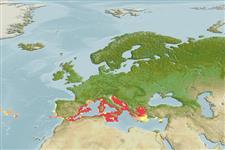| Native range | All suitable habitat | Point map | Year 2100 |

|
| This map was computer-generated and has not yet been reviewed. |
| Raja asterias AquaMaps Data sources: GBIF OBIS |
Utilização humana
Pescarias: pouco comercial
Phylogenetic diversity index
(Ref. 82805)
PD50 = 0.5000 many relatives (e.g. carps) 0.5 - 2.0 few relatives (e.g. lungfishes)
Nível Trófico
(Ref. 69278)
3.5 ±0.37 se; Based on food items.
Resiliência
(Ref. 69278)
Baixo, tempo mínimo de duplicação da população 4,5 - 14 anos (Fec assumed to be <100)